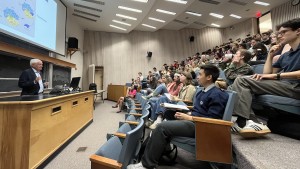When Joachim Frank set foot on campus this week, he brought with him credentials that include both a Nobel Prize and a recently published novel.
After spending a day engaging with Kenyon students and faculty — including a lunch with science majors and a meeting with representatives of the science and nature writing program — Frank was pleased to discover his own interdisciplinary interests mirrored around him.

“It was remarkable to me to see people who really have an interest both in humanities and science at the same time, and then the fact that even classes are taught in which both subjects are brought together,” he said.
A professor of biochemistry and molecular biophysics and biological sciences at Columbia University, Frank’s pioneering role in the development of cryogenic electron microscopy has led to far-reaching advancements in the imaging of biological molecules, including proteins.
Thanks to the work of Frank — who figured out how to create sharp 3D images by analyzing and merging blurry two-dimensional images from an electron microscope — and his co-winners of the Nobel Prize for Chemistry in 2017, scientists now can generate three-dimensional structures of biomolecules that have assisted in the development of pharmaceuticals related to viruses like COVID-19.
Frank discussed advancements in cryo-electron microscopy with the campus community during a pair of Sept. 17 appearances. These included a packed morning seminar with students in Higley Hall auditorium and a public colloquium in the evening.
His daylong visit, which also included tours of campus facilities, left him feeling excited about the College.
“I’m very impressed by the physical facilities and the wide interests of the faculty and the curiosity of the students,” he said.
Professor of Biology Wade Powell said it was noteworthy to have such a world-renowned scientist on campus.
“In a real sense, his group has propelled the field of structural biology from the old era of still photographs to a modern one that delivers molecular movies,” he said. “Such detailed imagery is not only fascinating from merely a basic science perspective; it will also enable new strategies for the rational design of novel drugs.”
The Royal Swedish Academy of Sciences said the technique helped usher in a “new era” in biochemistry when it announced him as a winner of the Nobel Prize for Chemistry in 2017 along with Jacques Dubochet and Richard Henderson.
It’s a topic that holds great interest for students, who were eager to get Frank’s take on the advantages and challenges of cryo-electron microscopy compared to other approaches as well as the appropriate role of artificial intelligence. It was a particularly timely subject, too, Powell said.
“The seminar could not have been timed better to mesh with our current structural biology topics in BIOL 263 (Molecular Biology),” he said.
Dilara Sen ’25, an honors physics student, said she was excited to learn about how the work of Frank — who studied physics at the University of Freiburg, the University of Munich and the Technical University of Munich — cut across different scientific disciplines.
“What was really, really inspiring to see was how he’s a physicist but his work was so much of biology and chemistry and how all the three different fields can combine together,” she said.
Sam Kovach ’25, another honors physics student, took comfort in the fact that Frank’s hard work over a number of years paid off in the long term.
“It was very cool just to see the process of how he developed his ideas and the refinement of his process and technique over many, many years,” he said.
Frank’s visit was facilitated by Associate Professor of Physics Madeline Wade, who said the award-winning scientist — who also has a website dedicated to his original fiction, poetry and more — is a longtime family friend. Bringing him to meet with students and faculty was a perfect way to celebrate the College’s bicentennial, she said.
“I think everyone was curious,” she said. “When you meet someone who’s been so successful in a science career, it’s always interesting to hear their story, and he has a very interesting story.”
In a lifetime full of scientific discoveries, one of the most important for the Nobel laureate has nothing to do with science. Rather, it was the recognition that the solutions to difficult problems don’t come in straight lines; instead, they often are accidents that are influenced by every encounter along the way.
Whenever you’re stuck on a difficult problem, he advised students over lunch, sometimes the best solution is to take the advice of the 19th century German writer Heinrich von Kleist and talk about the problem with someone else.
“The very attempt to formulate your thoughts brings you further,” he said.
